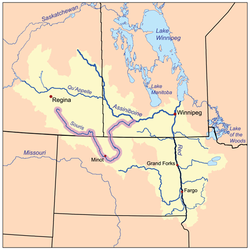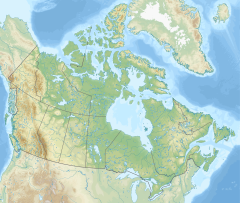| Long Creek | |
|---|---|
 Long Creek in Saskatchewan | |
 The Red River drainage basin, with the Souris River highlighted | |
| Location | |
| Countries | |
| Provinces | |
| State | |
| Towns | Radville, Sk |
| Physical characteristics | |
| Source | near Forward and Khedive |
| • location | Saskatchewan |
| • coordinates | 49°37′04″N 104°28′40″W / 49.6178°N 104.4778°W |
| Mouth | Souris River |
• location | Saskatchewan |
• coordinates | 49°07′00″N 102°59′24″W / 49.1168°N 102.9900°W |
| Discharge | |
| • location | Boundary Dam, south of Estevan |
| Basin features | |
| River system | Red River drainage basin |
| Tributaries | |
| • left | Gibson Creek |
| • right | Larson Reservoir |
Long Creek is a river[1] in central North America that begins in Saskatchewan, flows south-east into North Dakota,[2] and then flows back north into Saskatchewan. It is a tributary of the Souris River.[3] The Souris River drains into the Assiniboine River, which is part of the Red River drainage basin in a region called the Prairie Pothole Region of North America, which extends throughout three Canadian provinces and five U.S. states. It is also within Palliser's Triangle and the Great Plains ecoregion.[4] In 1957, a dam was built on Long Creek near where it meets the Souris River to create Boundary Dam Reservoir.

In 1873, the Boundary Commission set out from Pembina, Dakota Territory to survey the Canada–United States border. The route used by the commission followed several rivers near the border, including Long Creek. In 1874, the North-West Mounted Police followed the same route along Long Creek on their March West to deal with the Cypress Hills Massacre.
- ^ "Long Creek". Canadian Geographical Names Database. Government of Canada. Retrieved 12 October 2022.
- ^ "Long Creek, ND - Long Creek, North Dakota Map & Directions - MapQuest". www.mapquest.com.
- ^ "The Encyclopedia of Saskatchewan | Details". esask.uregina.ca.
- ^ "Drought in Palliser's Triangle | the Canadian Encyclopedia".

